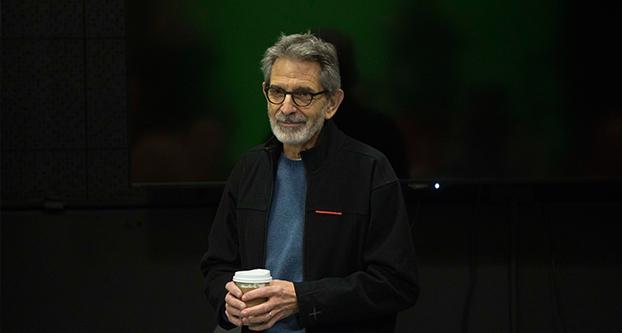Academy Award-winning visual effects supervisor Michael Fink visited Fresno State last Friday to speak on his time in the film industry and the advancements in the field of visual effects.
Fink’s presentation and visit to Fresno was part of the Big Tell Showcase, a mini-documentary film festival focusing on stories about the Central Valley put on by the Central Valley Community Foundation.
Fink got his start in film after working as a money manager and then a starving artist. The first film he worked on was “The China Syndrome” in 1977 after a friend offered him a job. He, along with other crew members, built a computer to simulate a nuclear reactor.
“The film was on schedule, on budget. It was perfect in every way,” he said. “Everyone was super-collaborative. The script was good. The actors ”’ Jane Fonda, Jack Lemmon, Michael Douglas ”’ the principle cast was spectacular. I’ve been looking ever since to repeat that experience, the on-schedule, on-budget part, along with everyone being nice.”
Fink went on to work on “Startrek: The Motion Picture,” “Blade Runner,” “The Adventures of Buckaroo Banzai Across the 8th Dimension,” and “Project X.”
He received his first credit as visual effects supervisor for his work on “WarGames” in 1983, and he was nominated for an Academy Award for “Batman Returns” in 1993.
Fink won the 2008 Academy Award for Best Visual Effects for the movie “The Golden Compass.”
“The interesting thing about ‘Golden Compass’ is the techniques from [this presentation] and the methods we used [and] we developed to make this film are still used,” he said. “There were almost no live-action animals that were used.”
Fink explained that he had to animate the animals in the movies as they interacted with human actors, the physical environment and other animated sets and characters.
“What you don’t think about are all the reflections and the shadows,” he said. “Animating a character is one thing, but animating a character and making that monkey [in “The Golden Compass”] walk next to Nicole Kidman and look like they’re as much in the film as Nicole Kidman is ”’ that’s where the art is.”
Fink said that while his work implementing computer graphics with live action has shown the development of technology over time, he still thinks back to what he might have done differently on past projects.
“I still wake up in the middle of the night about shots I had done 35 years ago,” he said. “I can’t watch ‘Buckaroo Banzai’ without cringing all the way through, and those effects were considered fantastic at the time. Oh my God, they’re embarrassing.”
However, Fink is still proud of many of his earlier works, including designing the flux capacitor in “Back to the Future” and animating Nightcrawler in the opening sequence of “X2,” the second “X-Men” film. The process is what makes the films special, he said.
“I love preproduction because it’s filled with all the hope and the wonder and the imagined excellentness of everything you’re gonna do,” he said.
For art animation major Cadence Calvert, hearing from Fink provided good insight into the industry.
“I want to go into movies, and so you gotta take whatever opportunities you can to learn about it and make connections,” Calvert said.
She said she has seen many movies Fink worked on, and though some of the effects are less modern, much of the animation has held up over time.
“I thought that it was very useful to get a perspective by someone who has worked in the industry for a long time, has seen it change and has a good feel for where it is right now and just to be aware of the changes that are going on right now, where the technology is, where it’s headed,” she said.
Calvert said her biggest takeaway was to make friends within the industry and to be versatile.
“You gotta learn photography. You gotta learn the computer programs. You gotta learn the art stuff, all the lighting and pick up as much as you can,” she said. “And, of course, everything comes down to the story.”
Paul Luna, a junior majoring in media, communications and journalism, said he was attracted to the event for both a class assignment and potential career advice.
“I’ve always wanted to get into film, and you always just kind of look at what’s in front of you and take that for granted. But really getting opportunities like this to see what goes on behind the screen makes you see the hard work that goes into it,” he said. “It also goes to show how great [Fink] is because he takes into consideration all those little details.”
Luna said he attended another workshop as part of the Big Tell Showcase, and he appreciated Fink explaining that work in film can be done anywhere.
“It just seems really far-fetched when you tell somebody that you want to get into film and stuff, and having people from that profession come in and let you know that it’s possible. It kind of helps broaden your horizons and see that there’s more,” Luna said.




